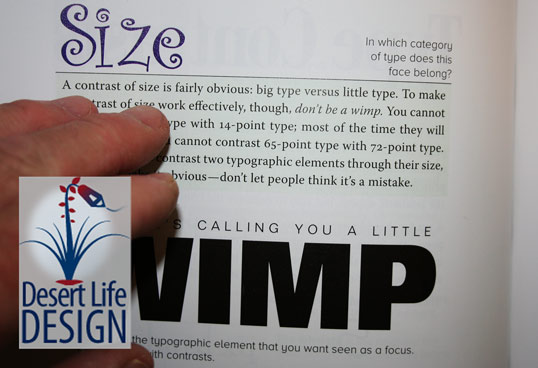5 design principles
5 design principles to make you a better designer
Here in the southwestern desert at Desert Life Design, we use graphic design, photography, and creative writing to create a compelling call-to-action.
I was a non-designer
by Doug Martin
Desert Life Design™
I've never been formally trained as a graphic designer. In the past, I've owned-and-operated an offset printing shop, and have worked with some really excellent graphic designers. But, when I tried to do graphic design myself, the results were amateurish.
Gestalt principles of visual perception
In an attempt to become a better designer, I studied the Gestalt principles of visual perception. The word, Gestalt, is used in psychology and refers to how we subconsciously organize the things we see into groups. When we subconsciously and instantly combine the groups, we see a unified whole that is greater than the separate elements.
For some reason, our human brains need to make sense out of our chaotic world. When we view an advertisement, we automatically try to force the content into unified wholes. We group individual elements of type and other design elements together into one cohesive unit.
One practical book I've used to become a better graphic designer is The Non-Designer's Design Book by Robin Williams. In her book, the author illustrates her design principles with easy-to-follow examples of bad and good designs. See our review of this book on Our Book Banter!
What is the call-to-action?
When a graphic design appears amateurish, just as mine used to (and sometimes still do), the elements of type, illustrations, photos, and message don't create a unified whole for the viewer. Instead, the viewer sees a jumbled mess, and it's difficult to figure out the important call-to-action.
To make my designs more effective, I have studied the diverse Gestalt principles of visual perception. Then, to make them easy-to-use in my own life of graphic design, I've combined and condensed them into five simple concepts.
Ironically, these principles not only helped me become a better graphic designer, but also helped me as I've landscaped my property and decorated my house. You, too, can be a better designer by using these principles, no matter what you do for a living.
5 design principles to make you a better designer
1. Alignment or balance
Everything in nature has an alignment, balance, or sense of symmetry. In graphic design, we must align our type and other design elements on the page to convey a message. Even without words, our alignment of elements will convey a message.
The designer uses basic styles of alignment to create unity, organize the content, and communicate a message. They are:
— Symmetrical or formal balance
A symmetrical alignment means that elements are the same on the left, right, top, and bottom of the page. Our human faces and bodies have a symmetrical or formal balance. The left side of our bodies is basically a mirror image of our right sides.
Symmetrical alignments suggest conservative, dependable, or trust-worthy attributes. Financial institutions, such as banks or insurance companies, might use a symmetrically-balanced layout to convey financial stability and honesty.
Churches, synagogues, mosques, and other places of worship that I've visited usually have a symmetrical design. The right side of the building is a mirror image of the left side. The symmetry of those buildings subliminally convey a message of stability and integrity.
— Asymmetrical or informal balance
Asymmetrical designs are visually more dynamic and adventurous than the more conservative symmetrical design. The left and right side are different from each other. They are not identical to each other like the symmetrical design.
To create an asymmetrical graphic design, you could vary the position, angle, or size of type or other elements to emphasize importance. The position difference creates contrast, which also conveys a message.
An asymmetrical design implies a young, bold, competitive, or adventurous character. I think asymmetry looks especially daring when used in combination with a symmetrical layout. All it takes it one asymmetrical element to really add vibrancy to a design.
To organize text into a symmetrical or asymmetrical layout, use these types of alignment:
- flush left
- flush right
- justified, or
- centered
2. Contrast
Contrast stimulates interest. The graphic designer might add contrast by varying the size of type between headings and text. Or, you might try using serif and sans serif type. For instance, the online version of The Washington Post uses serif type for their headings and sans serif type for their text.
Other ways to create contrast is to use a warm color with a cool color. Or, place a small element next to a large graphic.
The designer can also use contrast to show which item is most important. A large element instantly communicates its importance to the reader.
When using contrast, don't use too many contrasting elements. Too many different typefaces, colors, or sizes creates a confusing message. On the other hand, when you make elements different, really make them different. Kind-of-different doesn't get the job done.

Here's an example from The Non-Designer's Design Book showing how to add contrast
3. Proximity
To effectively use proximity, the designer should group related elements in the design together. The close proximity will tell the reader that these elements go together. Unrelated elements should be placed in a separate group.
Use white space to frame different units of ideas or messages that belong together. In design, white space is an important element and framing device. Use empty white space to frame different groups so the reader can move from one group to the other.
4. Repetition
Repetition happens in nature all the time, just like all the other principles we've already discussed. Seeds from plants fall nearby, and soon there are repetitive groupings of plants. Repetition looks natural to us in nature. In our designs, repetition makes subliminal sense, too.
In graphic design, repetition helps unify our content. In practical terms, we can repeat design elements, such as color, type styles, and alignments. Repetition creates a consistency that guides the reader to our call-to-action.
5. Simplify for easy-to-read simplicity
The people who view our designs see many different elements, including type and photos. To make sense of everything, they will automatically try to simplify the message into a unified whole. That's what the Gestalt principles of visual perception is all about.
By using appropriate alignment, contrast, and repetition, we make it easy for our audience to simplify our message. We also make our call-to-message more compelling.
“People will perceive and interpret ambiguous or complex images as the simplest form(s) possible.”
— fundamental theory of the Gestalt principles
Even though I'm kind-of old now, I'm glad I learned the simple secrets of good design while I was a younger offset printer. The principles I wrote about can be applied not only to graphic design, but to any design in life. That includes landscape design and interior design. In fact, I've found that designing is fun.

Desert Life Design™ is based in the Phoenix, Arizona metro area. Here, we strive for perfection in graphic design and concise written communications.
